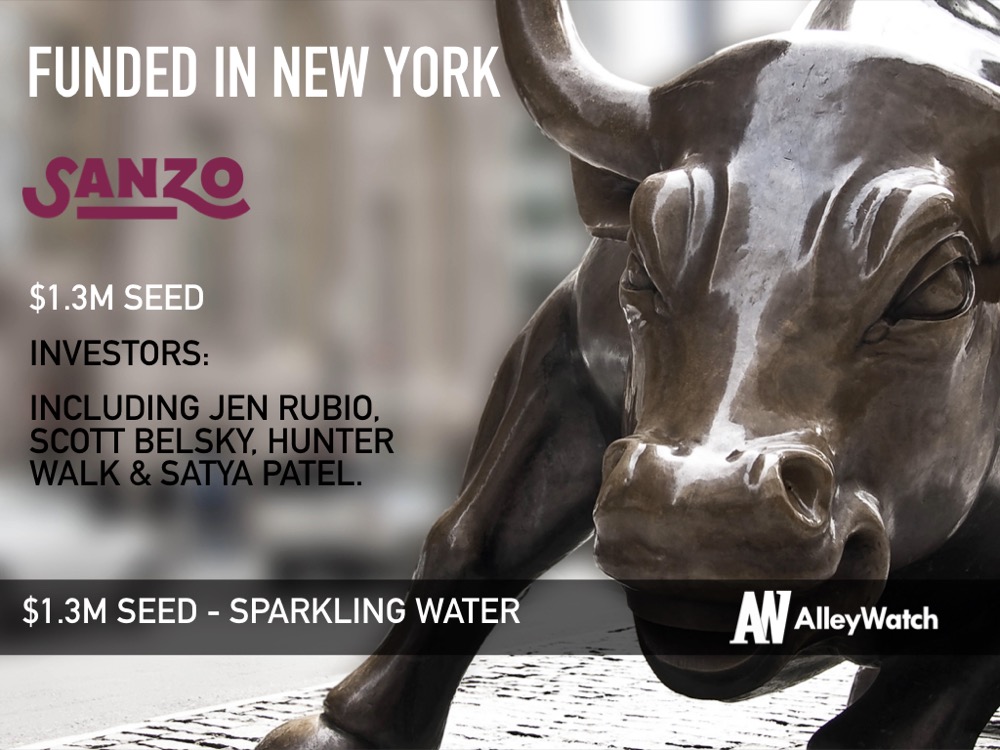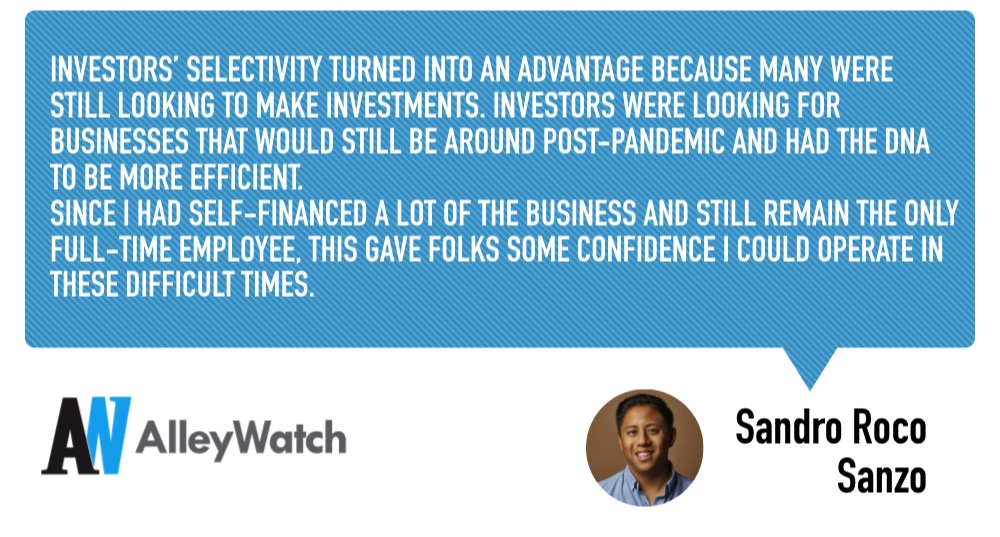The global sparkling water market is rapidly growing and people are looking for beverages that not only taste good but also are good for you. Sanzo is the first Asian-inspired sparkling water and it’s catching consumers’ attention. Available direct-to-consumer or in retail locations like Whole Foods, Sanzo offers three low-calorie flavors: lychee, alphonso mango, and calamansi (a Filipino lime/orange hybrid). All flavors are made with real fruit, no added sugar, or preservatives. The company has experienced tremendous growth during COVID-19 with a 400% increase in revenue.
AlleyWatch caught up with CEO and founder Sandro Roco to learn more about how the recent popularity of Asian culture in America inspired the launch of Sanzo, self-funding the company at launch, operating as a solo founder, and raising capital primarily through angel investors rather than funds.
Who were your investors and how much did you raise?
Sanzo raised $1.3M Seed with notable investors including Jen Rubio (cofounder of Away), Scott Belsky (CPO and Executive Vice President at Adobe Creative Cloud), Hunter Walk & Satya Patel (founders of Homebrew) and Dan Teran (founder of Managed by Q).
Tell us about the product or service that Sanzo offers.
Sanzo is the 1st Asian-inspired sparkling water, using real fruit + no added sugars, artificial or “natural” flavors to flavor our beverages. Our core line consists of 3 flavors: lychee, alphonso mango, and calamansi (a Filipino lime/orange hybrid).
What inspired the start of Sanzo?
In mid-2018, Crazy Rich Asians was the No.1 film at the box office, Korean pop (K-pop) was hitting a fever pitch, and it was becoming clearer that American culture is increasingly being influenced by Eastern culture. Yet, there wasn’t a beverage on the shelf that was adequately capturing this cultural wave.
I was working at a startup, where the fridges were filled with sparkling water and realized flavored sparkling water was a great way to introduce a broader audience to the Eastern flavors I’d grown up with.
How is Sanzo different?
Unlike most flavored sparkling water brands, Sanzo uses real fruit to flavor its beverages. And unlike most fruit-based sodas, Sanzo adds no sugar to its beverages, providing customers with a healthy, natural, low-calorie way to experience authentic flavors from Asia.
Our mission is to bridge cultures by connecting people to global flavors, and we ultimately believe sparkling water is a great way to build bridges.
What market does Sanzo target and how big is it?
The sparkling water market is currently $3B and has experienced double-digit YOY growth over the last 5+ years. And it’s directly taken that share from the $27B carbonated soft drink (CSD) market, which has declined every year for the last 10+ years as customers seek healthier alternatives.
Sanzo also reflects an American culture that is increasingly Easternized. Asian Americans/Pacific Islanders are the fastest-growing and highest-earning racial demographic in the United States.
Consumers across the board are increasingly looking for clean-label, Asian-inspired goods at the supermarket.
What’s your business model?
Sanzo sells directly to consumers and retailers through its website and to food & beverage wholesale distributors.
How has COVID-19 impacted the business?
Since shelter-in-place orders began, Sanzo has experienced >600% growth in its DTC channel, which has driven over 4x revenue for the brand.
What was the funding process like?
Throughout the months of June and July, it felt like an endless stream of phone calls and Zoom video chats, all of which were taking place in my parents’ basement as I went home to NJ to be with my father.
But meeting these angel investors and founders (we raised less than 5% of our capital from funds) was life-changing; they supported me and the brand and gave tactical advice about how to grow the business, I’m so grateful for the fundraising process.
What are the biggest challenges that you faced while raising capital?
The pandemic has made investors more selective about how they deploy capital. During the fundraising process, I had to clearly articulate how I’d spend investors’ money, and potential investors really had to believe in Sanzo because I’m the sole founder and only full-time employee.
What factors about your business led your investors to write the check?
Investors’ selectivity turned into an advantage because many were still looking to make investments. Investors were looking for businesses that would still be around post-pandemic and had the DNA to be more efficient.
Since I had self-financed a lot of the business and still remain the only full-time employee, this gave folks some confidence I could operate in these difficult times.
What excites me most though is that every investor we have onboard shares my same sentiment about the generational trend we are living through. We’re seeing it in our e-commerce sales during shelter-in-place, and we’re now starting to see it as we win retail distribution deals, most notably our recent launch at Whole Foods.
What are the milestones you plan to achieve in the next six months?
We have financial milestones that for now, I’ll keep internal. But as the founder, my mission is to build a brand that operates with integrity and that uplifts the communities we come from.
We’ve been so fortunate in our first year to have so many people (both Asian-American and not) rally behind us, and I don’t take that lightly. We’ve tried to use our platform as a way to shine a light on folks doing meaningful work either as restaurateurs or in their local communities (especially frontliners), and that is something I’m committed to keep doing as our brand grows.
What advice can you offer companies in New York that do not have a fresh injection of capital in the bank?
First off, if I was able to grow Sanzo and achieve profitability without raising money, I 100% would’ve chosen that path. Having worked in startups for 5 years beforehand, I’ve seen the impact raising venture capital money can have. It’s not “bad” per se, but it does come with expectations.
So, let me get that out of the way.
As for Sanzo, I self-financed this business for quite a while, which meant (pre-pandemic) taking subways with a hand truck, Ubers at 6AM to beat traffic and surge pricing and meeting 1:1 with customers, retail partners, and suppliers.
These experiences have helped me become a better operator and ask better questions as we’ve scaled.
The main thing I’d advise is pretty simple: stay lean, stay building, and stay in business. We seem to still have an obsession with the narrative of an “overnight success”, and time after time this narrative has been dispelled. Great brands take time to build.
The main thing I’d advise is pretty simple: stay lean, stay building, and stay in business. We seem to still have an obsession with the narrative of an “overnight success”, and time after time this narrative has been dispelled. Great brands take time to build.
Particularly during the pandemic, a lot of business owners have had to play defense, in many instances through no fault of their own. In the grand scheme of things, just coming out of this pandemic and staying in business is a huge accomplishment.
But if you’re able to start playing offense, whether by pivoting or creating alternate revenue streams, I think you’ll be rewarded.
The old adage of the best companies being born in adverse economic conditions is true because it forces entrepreneurs to focus and deliver real value to consumers.
The old adage of the best companies being born in adverse economic conditions is true because it forces entrepreneurs to focus and deliver real value to consumers.
Where do you see the company going now over the near term?
We have exciting retail launches in-play such as our roll-out at Whole Foods in the Northeast. We have some other exciting launches coming in the Fall as well.
Between retail launches and bolstering our e-commerce and digital marketing efforts, our focus is on meeting the customer where they are. This focus is even sharper for as long as this pandemic persists.”
What’s your favorite outdoor dining restaurant in NYC?
Saigon Social in the Lower East Side. Launched by Helen Nguyen (formerly of Daniel and Pat Lafrieda), Saigon Social’s garlic noodles with soft-shell crab have been a much-enjoyed indulgence during this stressful time.
She is also a retail partner of Heart of Dinner, a program that as of today has served over 20,000 meals to the elderly in Chinatown during the pandemic.
You are seconds away from signing up for the hottest list in New York Tech! Join the millions and keep up with the stories shaping entrepreneurship. Sign up today





